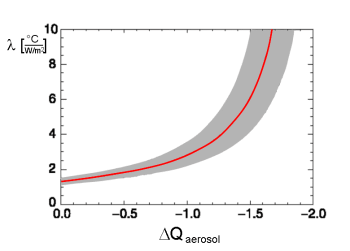 > ACCENT en > Special: July 05 Greenhouse Earth > R: a model calculation
> ACCENT en > Special: July 05 Greenhouse Earth > R: a model calculation
|
How does the climate equation work?A simple model calculation
|
|
We demonstrate the aerosol problem in a few simple calculations: In a climate model there are certain factors which drive (force) the climate system. These forcings can be positive and lead to a warming. They can also be negative and lead to a cooling. We call a forcing “delta Q”. If the driving factors change with time (for example from industrialisation until today) because the greenhouse gases accumulate or the average solar radiation or cloudiness change, the average temperature on the Earth (“delta T”) also changes. The change in temperature is larger the more sensitive the climate system reacts to changes in the forcing. This climate sensitivity is expressed by the Greek letter “Lambda”. We can write now: Temperature change = climate sensitivity x forcing
|
 |
|
with: |
Temperature change in the considered time range |
||
| Climate sensitivity | ||
| Change in the forcing during the considered time (in watts per square meter) |
|
Climate research investigates which chemical and physical parameters stand behind these driving forces. A major factor are the greenhouse gases: carbon dioxide, methane, ozone, nitrous oxide, CFCs. Their fraction in the air has increased considerably since industrialisation. Greenhouse gases retain the energy of the infrared radiation close to the Earth. This radiative forcing brings in about +2.4 W/m2. |
 |
|
|
|
A simple calculation with whole numbers demonstrates that the climate sensitivity is strongly dependent on the aerosol cooling. We assume that a temperature change of 2°C has been observed. Furthermore the climate forcing coming from greenhouse gases and other factors may sum up to 2 W/m2. Since we do not know exactly what the contribution of the aerosol cooling is, we assume values of: 0 ; -1 ; -1.5 ; -1.75 W/m2. What is the resulting climate sensitivity?
We see that the climate sensitivity takes values of 1, 2, 4 and 8°C per W/m2. This is very uncertain. Such a wide uncertainty is also given in the scientific climate calculations. Climate models use, for example, sensitivities of 1.5 to 4.5°C per W/m2.
|
|
What will happen if we assume that the aerosol cooling is rather high (about 1.5 W/m2), but will decrease in the near future, while in parallel the amount of greenhouse gases in the air is increasing? We choose some numbers:
As we can see, the global temperature would increase significantly. This example of a climate model calculation is strongly simplified. But it explains the basic thoughts which are behind the worries of the scientists.
|

